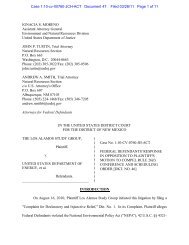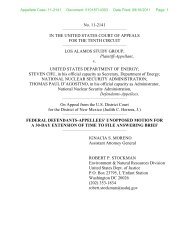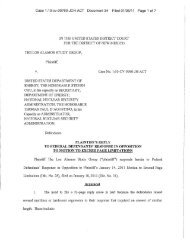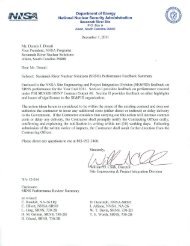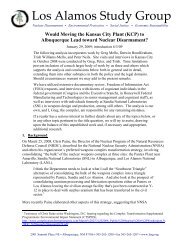Assessing Approaches to Weapon Life Extension Programs (LEPs)
Assessing Approaches to Weapon Life Extension Programs (LEPs)
Assessing Approaches to Weapon Life Extension Programs (LEPs)
Create successful ePaper yourself
Turn your PDF publications into a flip-book with our unique Google optimized e-Paper software.
N A T I O N A L N U C L E A R S E C U R I T Y A D M I N I S T R A T I O N<br />
O F F I C E O F D E F E N S E P R O G R A M S<br />
<strong>Assessing</strong> the Current (former, future …)<br />
<strong>Approaches</strong> <strong>to</strong> <strong>Weapon</strong> <strong>Life</strong> <strong>Extension</strong><br />
<strong>Programs</strong> amidst Fiscal Constraints,<br />
New Priorities<br />
Presentation <strong>to</strong><br />
5th Annual Nuclear Deterrence Summit<br />
Crystal City, VA<br />
February 20, 2013<br />
Dr. Donald Cook<br />
Deputy Administra<strong>to</strong>r for Defense <strong>Programs</strong> (NA-10)
National Strategic Policy for Nuclear<br />
<strong>Weapon</strong>s has been clearly formulated<br />
“The United States will take concrete steps <strong>to</strong>wards a world<br />
without nuclear weapons... Make no mistake: As long as<br />
these weapons exist, the United States will maintain a<br />
safe, secure and effective arsenal <strong>to</strong> deter any adversary,<br />
and guarantee that defense <strong>to</strong> our allies...”<br />
President Obama, April 5, 2009<br />
Prague, Czech Republic<br />
“Conduct research and development on a broad range of safety, security,<br />
reliability, and control methods and devices for nuclear warheads and<br />
weapon systems, including use control, and delay and denial capabilities. As a<br />
long-term goal, pursue technologies that render the unauthorized use of<br />
U.S. nuclear weapons impossible without their remanufacture.”<br />
National Security Presidential Directive/NSPD-28<br />
2
National Strategic Policy for Nuclear<br />
<strong>Weapon</strong>s has been clearly formulated<br />
The NPR stated the following as priorities, among others:<br />
“…providing annual s<strong>to</strong>ckpile assessments through weapons<br />
surveillance.”<br />
“…funding fully the ongoing LEP for the W76 submarine-based<br />
warhead and the LEP study and follow-on activities for the B61<br />
bomb…”<br />
“…initiating a study of LEP options for the W78 ICBM warhead,<br />
including the possibility of using the resulting warhead also on SLBMs<br />
<strong>to</strong> reduce the number of warhead types…”<br />
“…the science, technology and engineering base, vital for s<strong>to</strong>ckpile<br />
stewardship as well as providing insights for non-proliferation, must be<br />
strengthened…”<br />
Department of Defense, “Nuclear Posture Review”, April 2010<br />
3
National Strategic Policy for Nuclear<br />
<strong>Weapon</strong>s has been clearly formulated<br />
… and executed<br />
NPR Implementation: Results so far<br />
The NPR stated the following as priorities, among others:<br />
“…providing annual s<strong>to</strong>ckpile assessments through weapons<br />
surveillance.” Surveillance funding increased significantly<br />
“…funding fully the ongoing LEP for the W76 submarine-based<br />
warhead and the LEP study and follow-on activities for the B61<br />
bomb…”<br />
W76-1 build rate achieved; all required weapons delivered in FY12<br />
B61-12 LEP now in Phase 6.3<br />
“…initiating a study of LEP options for the W78 ICBM warhead,<br />
including the possibility of using the resulting warhead also on SLBMs<br />
<strong>to</strong> reduce the number of warhead types…” W78/88-1 now in Phase 6.2<br />
“…the science, technology and engineering base, vital for s<strong>to</strong>ckpile<br />
stewardship as well as providing insights for non-proliferation, must be<br />
strengthened…” ST&E base has been sustained, some elements<br />
strengthened; e.g., Pu subcrit expts, component technology maturation<br />
Department of Defense, “Nuclear Posture Review”, April 2010<br />
4
Four Assertions<br />
1. We have the oldest s<strong>to</strong>ckpile we have ever had (avg. life > 26 yrs)<br />
and the smallest s<strong>to</strong>ckpile since the Eisenhower administration.<br />
2. Currently, we expend substantial effort in understanding the<br />
effects of warhead aging (because we must), but we desire <strong>to</strong> reset<br />
the clock (remanufacture and modernize warheads).<br />
3. In the first two decades post NTE (nuclear test era) we built the<br />
“power <strong>to</strong>ols” of S<strong>to</strong>ckpile Stewardship. In the next two decades,<br />
we must apply those power <strong>to</strong>ols <strong>to</strong> modernization of the US<br />
nuclear deterrent writ large (people, s<strong>to</strong>ckpile, infrastructure,<br />
business practices).<br />
4. “Regularizing” the activities in S<strong>to</strong>ckpile Stewardship and<br />
Management, in such a way as <strong>to</strong> use the capabilities we must<br />
have, is an effective manner of continuous capability maintenance<br />
and renewal.<br />
5
Evolution of the S<strong>to</strong>ckpile<br />
6
S<strong>to</strong>ckpile sustainment encompasses a broad set<br />
of activities within Defense <strong>Programs</strong><br />
To be effective, NNSA’s s<strong>to</strong>ckpile management strategy must achieve the<br />
following:<br />
• Sustain the s<strong>to</strong>ckpile, both active and hedge, through:<br />
Maintenance<br />
Alterations<br />
Modifications<br />
<strong>Life</strong> <strong>Extension</strong> <strong>Programs</strong> (<strong>LEPs</strong>).<br />
• Respond effectively <strong>to</strong> geopolitical challenges, arms control opportunities,<br />
and technical surprises<br />
Sustain a highly specialized technical workforce<br />
Develop and sustain capabilities, facilities and infrastructure essential <strong>to</strong><br />
supporting dynamic s<strong>to</strong>ckpile requirements<br />
A well-planned and well-executed strategy will enable NNSA and DoD <strong>to</strong> build a<br />
deployment and hedge strategy consistent with the goal <strong>to</strong> establish a smaller,<br />
yet effective, nuclear deterrent<br />
7
Safety, Security and Reliability are the Key<br />
Elements of S<strong>to</strong>ckpile Sustainability<br />
• Continual surveillance and performance assessments of the<br />
s<strong>to</strong>ckpile underpin reliability and safety<br />
Modern system baselines rely on advanced computational models and<br />
an assimilation of data from the UGT and post-UGT eras<br />
In-depth evaluation of nuclear and non-nuclear components and<br />
materials; functional component, labora<strong>to</strong>ry, and flight tests<br />
• Certification and annual assessment of the state of the s<strong>to</strong>ckpile<br />
through comprehensive theoretical modeling validated by<br />
comparison with test data and current experiments<br />
• Detailed formulation of <strong>Life</strong> <strong>Extension</strong> Plans (LEP) for each system<br />
includes safety and security considerations<br />
Use of insensitive high explosives is a goal for all systems<br />
Plan meets military requirements and policy commitments<br />
Validation of LEP activities through modeling and experiments<br />
8
LEP Planning Framework<br />
Requirements and<br />
Drivers<br />
Prioritizing and<br />
Planning Investment<br />
Decision<br />
Technology Development,<br />
Certification, and Component<br />
Maturation<br />
Technology Down-<br />
Select and<br />
S<strong>to</strong>ckpile Insertion<br />
Engineering, Readiness,<br />
S<strong>to</strong>ckpile Services<br />
(Development/Production)<br />
CMF<br />
Programmatic<br />
and Technical<br />
Source<br />
Requirements<br />
<strong>Life</strong> <strong>Extension</strong><br />
Options<br />
Science, ASC, ICF, Advanced<br />
Certification, Engineering<br />
Production Readiness/ RTBF<br />
PCF<br />
S<strong>to</strong>ckpile<br />
Modernization<br />
S<strong>to</strong>ckpile Services and<br />
Systems (Advanced<br />
Architecture)<br />
Requires continual advancement of the state of the<br />
art for each element of the framework<br />
9
Phase 6.x<br />
Flow of Science and Technology<br />
Deliverables <strong>to</strong> the LEP process<br />
Phase<br />
6.1Study<br />
Phase 6.2/2A<br />
Feasibility and Cost<br />
Study<br />
Phase 6.3<br />
Development<br />
Engineering<br />
Phase 6.4<br />
Production<br />
Engineering<br />
Phase<br />
6.5<br />
FPU<br />
Phase 6.6 Full<br />
Rate Production<br />
SSMP-PCF, CMF<br />
• Refurbishment options analyzed (PCF)<br />
• Determination of component lifetimes<br />
(CMF)<br />
Acronyms<br />
DA=Design Agency<br />
FPM=Federal Program Manager<br />
PA=Production Agency<br />
CMF<br />
• Component technology and manufacturing development<br />
• Integration between DAs, PAs, and FPMs<br />
PCF<br />
• Certification and qualification activities<br />
• Models and simulations of all aspects of weapon performance<br />
• Supplies computational <strong>to</strong>ols and data <strong>to</strong> the CMF<br />
10
A balanced plan for s<strong>to</strong>ckpile life extension across the<br />
deterrent platforms would levelize the workload<br />
Notional, partly balanced Plan<br />
A more evenly leveled plan could reduce large peaks and valleys by<br />
adjusting work schedules <strong>to</strong> fit within a “capability complex” framework<br />
11
Next Steps<br />
• Focus on <strong>Life</strong> <strong>Extension</strong> <strong>Programs</strong> <strong>to</strong> treat <strong>LEPs</strong> as major<br />
acquisition programs – which they are (FY13-14).<br />
• Incorporate Systems Engineering and Integration principles in<br />
further implementation of the 2010 Nuclear Posture Review,<br />
delivering on present commitments, and analyzing and making<br />
decisions regarding new commitments (FY13-14).<br />
• Conduct detailed analysis of the workforce requirements<br />
across the nuclear security enterprise <strong>to</strong> support integration of<br />
life extension programs and infrastructure modernization<br />
efforts (FY13-14).<br />
• Strengthen the linkage between modernization, transparency,<br />
and verification technologies in support of the New Start<br />
Treaty and any potential follow-on treaties (ongoing).<br />
12
Conclusions<br />
• Implementation of the 2010 Nuclear Posture Review is being pursued<br />
aggressively. The results show in an increased focus on support for the<br />
New Start treaty, nuclear non-proliferation, weapon life extension<br />
programs, infrastructure investments, and weapon dismantlements.<br />
• The S<strong>to</strong>ckpile Stewardship and Management Plan provides a roadmap for<br />
the advanced science, technology, engineering, and manufacturing<br />
development required <strong>to</strong> maintain the safety, security and reliability of<br />
the s<strong>to</strong>ckpile, and <strong>to</strong> extend it in<strong>to</strong> the future. The FY14 SSMP is being<br />
drafted, with intent <strong>to</strong> release following incorporation on PBR14.<br />
• The long-term cost of the US nuclear deterrent warheads will likely be<br />
minimized with commitment <strong>to</strong>, and execution of, a “regularized” level of<br />
activity across the nuclear security enterprise. Strong connections<br />
between modernization and transparency of operations will prove <strong>to</strong> be<br />
invaluable.<br />
13




